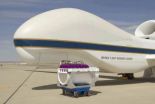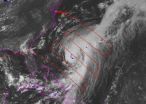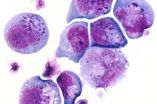(Press-News.org) VIDEO:
Global Hawk observes the Saharan Air Layer through the Cloud Physics Lidar(CPL) during Hurricane Nadine (id 4102). More information on this topic available at:
http://www.nasa.gov/content/goddard/nasa-hs3-instrument-views-2-dimensions-of-clouds/....
Click here for more information.
NASA's Cloud Physics Lidar (CPL) instrument, flying aboard an unmanned Global Hawk aircraft in this summer's Hurricane and Severe Storm Sentinel, or HS3, mission, is studying the changing profile of the atmosphere in detail to learn more about how hurricanes form and strengthen.
"CPL profiles the atmosphere to get a two-dimensional picture of cloud and aerosols, from the top down," said Matt McGill of NASA's Goddard Space Flight Center in Greenbelt, Maryland, who led the instrument team that designed and built the CPL. Its data, presented as if it were a curtain hanging from the sky, shows what's in the atmosphere's different layers.
From about 60,000 feet on the Global Hawk, twice the altitude of a commercial plane, 94 percent of the atmosphere lies below the instrument. The lidar works by sending rapid pulses of light that, like a radar beam, bounce and scatter off any particles they encounter, such as cloud droplets or dust particles. Some of the scattered light returns to the instrument where it records how long it took for the photons to leave and return – giving the altitude of the particles.
CPL sends out 5,000 pulses of light per second in three different wavelengths, allowing the science team to discriminate between different types of particles, McGill said. "Is it a cloud made of water? Is it a cloud made of ice or mixed [water and ice]? And we can say something about what type of airborne particle we are seeing. Is it dust or smoke or pollution?"
For the scientists studying hurricanes, those distinctions are important. One of the major areas of study is how Saharan dust off of Africa travels across the Atlantic and affects hurricane formation and intensification. CPL data have been used to verify model projections of Saharan dust in the tropics. The CPL data showed dust layers had a vertical distribution different than models predicted. Instead dust layers occupied narrower altitude ranges. The finding led to an improvement in the dust models, which then feed into hurricane models.
Situated in the nose of the Global Hawk flying over the storm environment, CPL also has a role in on-the-fly mission planning. While in flight, the CPL sends its data back to the team on the ground. "The mission scientists involved in the flight planning can sit there and watch the data with us in real time and say, 'Oh, we're not getting what we want.' Then they can go work with the flight planners and pilots to reroute the aircraft into different areas," said McGill. "They love that."
The airborne science community takes full advantage of the quick look capability, as well as the 24-hour turn around for the final data products. CPL is one of the most flown instruments in NASA's Earth science fleet. "It's a workhorse for the field campaigns," said McGill.
The original CPL was built in 1999 and took its first flight on the ER-2 high altitude research aircraft in 2000. Over the years CPL has been used as a satellite simulator for ground validation efforts, a cloud spotter for other instruments needing a clear view of the ground, as well as the main data collector for scientists studying atmospheric composition and Earth's energy budget where thin clouds and aerosols are major players. The lidar was also part of the proof of concept flights for the A-Train, a series of satellites flying in the same orbit making near-simultaneous measurements of the Earth system using many different instruments. That proof of concept airborne campaign showed scientists the power of combining multiple Earth observing data sets.
In 2007, when talk began of using Global Hawks for Earth science, CPL was among the first sensors considered; its size is perfect for the instrument compartment. Worries about the untested Global Hawk led to a second nearly identical instrument being built for use on the unmanned aircraft. It flew on NASA's maiden Global Hawk Pacific campaign in 2009. Since then, the Global Hawk CPL has flown in two multi-year campaigns, alternating between the Airborne Tropical Tropopause Experiment (ATTREX) and HS3.
Compact and fully autonomous, the CPL lidar design pioneered photon-counting technology that has led to the development of two instruments that will fly in space, the Cloud-Aerosol Transport System (CATS), which launches to the International Space Station this December, and the Advanced Topographic Laser Altimeter System (ATLAS), which will fly on the Ice, Cloud and land Elevation Satellite-2 (ICESat-2) scheduled to launch in 2017.
The solid design of the instrument has borne up surprisingly well over the years, said McGill, who uses CPL as a learning tool for interns and young scientists getting their hands dirty in the field. Together, the twin CPL instruments have flown 26 missions. HS3 will mark the 27th overall and the seventh for the Global Hawk CPL.
"It's still going strong," McGill said.
INFORMATION:
The HS3 mission is funded by NASA Headquarters and overseen by NASA's Earth System Science Pathfinder Program at NASA's Langley Research Center in Hampton, Virginia, and is one of five large field campaigns operating under the Earth Venture program. The HS3 mission also involves collaborations with partners including the National Centers for Environmental Prediction, Naval Postgraduate School, Naval Research Laboratory, NOAA's Hurricane Research Division and Earth System Research Laboratory, Northrop Grumman Space Technology, National Center for Atmospheric Research, State University of New York at Albany, University of Maryland - Baltimore County, University of Wisconsin and University of Utah. The HS3 mission is managed by the Earth Science Project Office at NASA's Ames Research Center in Moffett Field, California.
NASA HS3 instrument views 2 dimensions of clouds
CPL Instrument flying on NASA's Hurricane Research Mission
2014-09-16
ELSE PRESS RELEASES FROM THIS DATE:
NASA's HS3 mission covers transition of Hurricane Cristobal
2014-09-16
NASA's Global Hawk 872 aircraft flew over Hurricane Cristobal on August 28 and 29 and gathered data on the storm as it was becoming extra-tropical.
NASA's airborne Hurricane and Severe Storm Sentinel, or HS3, mission kicked off on August 26 when one of the remotely piloted Global Hawk aircraft flew a "lawnmower" or back and forth pattern over Hurricane Cristobal while gathering data using dropsondes and two other instruments. The Global Hawk dropped 81 dropsondes over Cristobal. A dropsonde is a device that measures winds, temperature, pressure and humidity as it falls ...
Results of OCT STEMI trial reported at TCT 2014
2014-09-16
WASHINGTON, DC – September 16, 2014 – The first randomized trial to examine serial optical coherence tomography (OCT) in primary percutaneous coronary intervention (PCI) was reported at the 26th annual Transcatheter Cardiovascular Therapeutics (TCT) scientific symposium. Sponsored by the Cardiovascular Research Foundation (CRF), TCT is the world's premier educational meeting specializing in interventional cardiovascular medicine.
OCT uses light emitted from an intravascular catheter to capture high-resolution cross sectional imaging from within coronary arteries. OCT ...
Results of IVUS-CTO trial reported at TCT 2014
2014-09-16
WASHINGTON, DC – September 14, 2014 – A new study found that intravascular ultrasound (IVUS) -guided intervention in patients with chronic total occlusion (CTO) could improve outcomes compared to a conventional angiography-guided approach during percutaneous coronary intervention (PCI). The IVUS-CTO study is the first randomized trial to examine the clinical impact of IVUS guidance for CTO intervention.
Findings were reported today at the 26th annual Transcatheter Cardiovascular Therapeutics (TCT) scientific symposium. Sponsored by the Cardiovascular Research Foundation ...
Epigenetic drugs: A hope to treat cancer resistance and reduce cancer relapse?
2014-09-16
High school biology taught us that we inherit certain traits from our parents that are pre-determined. But what if you could change how these genes play out by taking certain drugs or better yet, just changing your diet? That's exactly what a team of researchers at the Boston University School of Medicine (BUSM) have proposed through their research of epigenetics research.
Epigenetics regulates gene expression in a reversible manner by chemically modifying DNA and histone proteins, which prevent permanent mutations or alterations within the gene themselves. Throughout ...
Results of DKCRUSH-VI trial reported at TCT 2014
2014-09-16
WASHINGTON, DC – September 14, 2014 – A new study found that fractional flow reserve (FFR)-guided provisional side branch (SB) stenting of true coronary bifurcation lesions yields similar outcomes to the current standard of care. The DKCRUSH-VI clinical trial is the first study to compare FFR-guided and angiography-guided stenting.
Findings were reported today at the 26th annual Transcatheter Cardiovascular Therapeutics (TCT) scientific symposium. Sponsored by the Cardiovascular Research Foundation (CRF), TCT is the world's premier educational meeting specializing in ...
Results of RIBS IV trial reported at TCT 2014
2014-09-16
WASHINGTON, DC – September 14, 2014 – A new clinical trial comparing the use of everolimus-eluting stents (EES) and drug-eluting balloons (DEB) in treating in-stent restenosis (ISR) from drug-eluting stents found that EES provided superior late angiographic results and better late clinical outcomes.
Findings were reported today at the 26th annual Transcatheter Cardiovascular Therapeutics (TCT) scientific symposium. Sponsored by the Cardiovascular Research Foundation (CRF), TCT is the world's premier educational meeting specializing in interventional cardiovascular medicine. ...
UTMB professor implements lifesaving protocol for school children with severe allergies
2014-09-16
As the number of children with food allergies in the U.S. increases, so does the risk of children having a severe, potentially life-threatening allergic reaction called anaphylaxis on school campuses. School nurses often have treatment plans in place for students with diagnosed allergies, but many children have their first allergic reactions at school, where a specific medication, such as EpiPen epinephrine injectors, may not be available and a response protocol may not be in place.
Students with identified food allergies are generally well known to school nurses. School ...
Healthy humans make nice homes for viruses
2014-09-16
The same viruses that make us sick can take up residence in and on the human body without provoking a sneeze, cough or other troublesome symptom, according to new research at Washington University School of Medicine in St. Louis.
On average, healthy individuals carry about five types of viruses on their bodies, the researchers report online in BioMed Central Biology. The study is the first comprehensive analysis to describe the diversity of viruses in healthy people.
The research was conducted as part of the Human Microbiome Project, a major initiative funded by the ...
Benefit of endocrine therapy in elderly women with low risk hormone receptor positive breast cancer?
2014-09-16
Treatment with endocrine therapy and radiation therapy as part of breast conservation is the current standard of care for women with hormone-receptor positive (HR+) invasive breast cancer. A new study by researchers at Fox Chase Cancer Center, however, shows that combination may not be necessary for all patient populations with the disease.
The results, which Fox Chase researchers presented at the American Society for Radiation Oncology's 56th Annual Meeting on Sunday, September 14, suggest that low-risk patients over 65 years old with small tumors may achieve comparable ...
Study identifies when and how much various prostate cancer treatments will impact urinary and sexual functioning
2014-09-16
Men with prostate cancer may one day be able to predict when and how much various treatments will impact their urinary and sexual functioning, thanks in part to new findings that researchers at Fox Chase Cancer Center presented at the American Society for Radiation Oncology's 56th Annual Meeting on Tuesday, September 16.
Looking over data gathered from more than 17,000 surveys completed by men diagnosed with prostate cancer, Fox Chase researchers tracked when patients' urinary and sexual symptoms changed following each type of treatment, and by how much. "The ultimate ...
LAST 30 PRESS RELEASES:
Young adults commonly mix cannabis with nicotine and tobacco
Comprehensive review illuminates tau protein's dual nature in brain health, disease, and emerging psychiatric connections
Book prepares K-12 leaders for the next public health crisis
Storms in the Southern Ocean mitigates global warming
Seals on the move: Research reveals key data for offshore development and international ecology
Sports injuries sustained during your period might be more severe
World's first successful 2 Tbit/s free-space optical communication using small optical terminals mountable on satellites and HAPS
Can intimate relationships affect your heart? New study says ‘yes’
Scalable and healable gradient textiles for multi‑scenario radiative cooling via bicomponent blow spinning
Research shows informed traders never let a good climate crisis go to waste
Intelligent XGBoost framework enhances asphalt pavement skid resistance assessment
Dual-function biomaterials for postoperative osteosarcoma: Tumor suppression and bone regeneration
New framework reveals where transport emissions concentrate in Singapore
NTP-enhanced lattice oxygen activation in Ce-Co catalysts for low-temperature soot combustion
Synergistic interface engineering in Cu-Zn-Ce catalysts for efficient CO2 hydrogenation to methanol
COVID-19 leaves a lasting mark on the human brain
Scientists use ultrasound to soften and treat cancer tumors without damaging healthy tissue
Community swimming program for Black youth boosts skills, sense of belonging, study finds
Specific depressive symptoms in midlife linked to increased dementia risk
An ‘illuminating’ design sheds light on cholesterol
Who is more likely to get long COVID?
Study showcases resilience and rapid growth of “living rocks”
Naval Research Lab diver earns Office of Naval Research 2025 Sailor of the Year
New Mayo-led study establishes practical definition for rapidly progressive dementia
Fossil fuel industry’s “climate false solutions” reinforce its power and aggravate environmental injustice
Researchers reveal bias in a widely used measure of algorithm performance
Alcohol causes cancer. A study from IOCB Prague confirms damage to DNA and shows how cells defend against it
Hidden viruses in wastewater treatment may shape public health risks, study finds
Unlock the power of nature: how biomass can transform climate mitigation
Biochar reshapes hidden soil microbes that capture carbon dioxide in farmland
[Press-News.org] NASA HS3 instrument views 2 dimensions of cloudsCPL Instrument flying on NASA's Hurricane Research Mission



